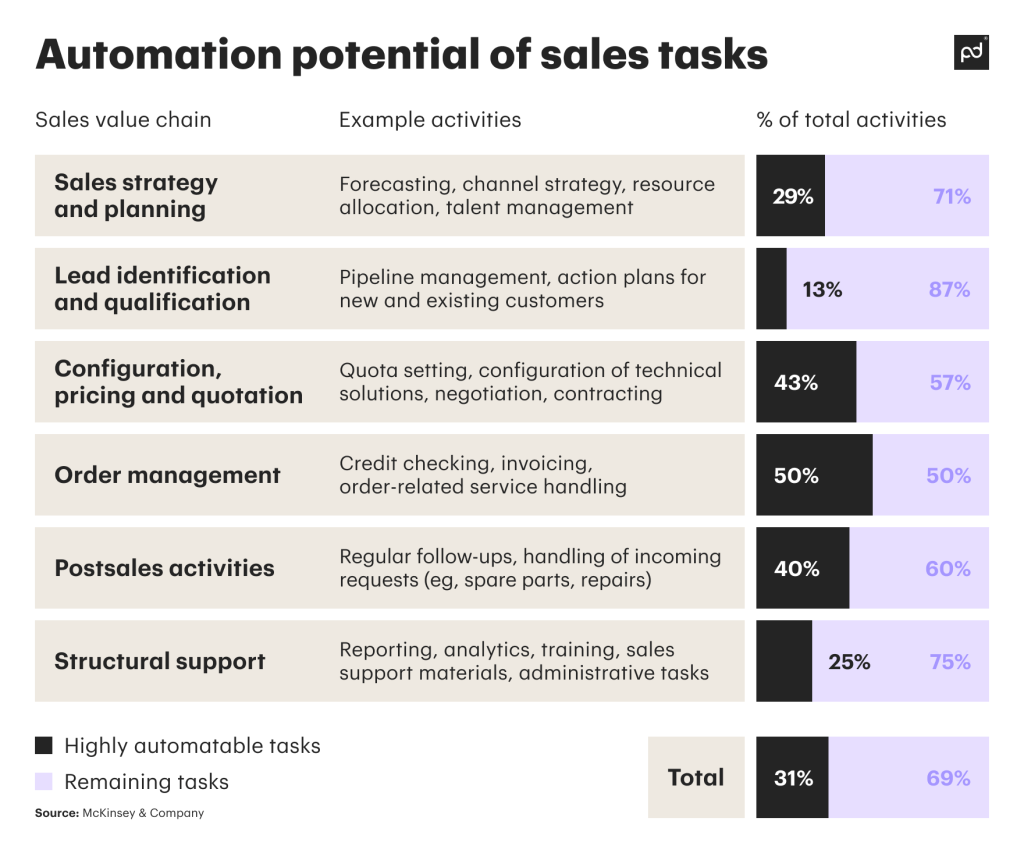There’s a simple reason behind automating sales processes — less time spent on low-value-added activities results in more time spent on actual selling.
That goes for the rest of your sales team stuck following established steps — how much of that time could they have spent doing something more productive than administering routine tasks?
What is sales process automation?
Sales process automation doesn’t only concern your sales team.
It also affects clients, partners, distribution channels, and other parties involved.
The ultimate goal is to enable salespeople to focus on closing deals and developing client relationships and spend less time on routine tasks.
Some examples of such repetitive sales activities include updating contact information in the CRM system, managing calendars, and setting up meetings or follow-ups.
However, there is more to sales automation than freeing up available time: sales automation tools can be used to create sales funnels tailored to individual customer journeys.
What is the main purpose of sales automation?
The primary purpose of sales automation is boosting your business revenue. With more value-added activities, your team can do its job quicker and more effectively.
Consequently, that leads to increased abilities of your team to scale their operations and apply more granular sales tactics.
How is sales automation implemented?
Juggling your priorities and trying to get a grasp of your sales automation activities can be nerve-wracking if you don’t know where to start.
According to McKinsey & Company, about 30% of all sales activities can be automated — order management, configuration, pricing, quotation, and post-sales activities are among the top automation priorities.

To get a better window into the importance of sales automation activities, let’s walk you down the sales pipeline.
Sales strategy and planning
Sometimes, sales strategy is referred to as a go-to approach plan that covers everything from using specific tools to timing and scripts.
However, this can arguably be described as a tactical approach rather than a strategy in a broader sense.
We suggest the definition of the sales strategy as securing long-term business revenue, which involves a great deal of forecasting, building processes, and budgeting.
The average sales forecasting accuracy is below 90%; if done manually, it can drop even further, as the chances of humans making a mistake increase drastically.
You can factor in historical sales performance, seasonality, lead volume, etc. If that is the case, Salesforce can be your one-stop shop here.
The company offers a great tool that can give you revenue projections, show potential bottlenecks, and help define winning patterns.
But if you’re looking to up your Salesforce automation process flow further, PandaDoc can speed up your workflow and provide additional insights with real-time document updates.
Lead identification and qualification
Only some leads you attract result in sales opportunities; lead scoring helps you identify those prospects that deserve the majority of your attention.
Pursuing something that can potentially result in a dead end can undermine your sales efforts, and that isn’t uncommon — more than 50% of B2B marketers overlook the lead qualification process.
As a result, as many as 67% of sales opportunities can be lost because sales representatives fail to properly identify their target customers.
So how can sales automation succeed where humans often fail? HubSpot helps you prioritize your leads based on thousands of data points within the system, uncovering your best potential deals.
On top of that, HubSpot perfectly integrates with PandaDoc, providing the best of two worlds: you can customize your document and send it out for approval using PandaDoc templates and e-signature capabilities; at the same time, you can also pull data from the HubSpot CRM to fill blank spaces while customizing documents in PandaDoc.
Configuration, pricing, and quotes
Requesting and sending proposals are normal tasks for many businesses, but they can take quite some time.
Starting a new proposal, you never know whether it will land a new business opportunity or if your offer will just get rejected.
Sometimes, sales departments even have to debate whether it’s worth making a proposal at all.
There are many reasons why your proposal can be rejected, whether the offering or price is unclear, or something as simple as a lack of visual representation.
Either way, it can be challenging enough to account for everything, so you should accept the possibility of your proposal being declined.
To beat the odds, PandaDoc provides you with advanced quote management, which empowers you to predefine your proposals with different sets of products and even set up recurring payments.
It’s only a matter of a few clicks to customize your offer and send it off for approval.
Order management
With proper order management, you can rest assured your business delivers orders quickly and accurately while keeping inventory costs low.
This is an essential part of your system’s logistics that keeps the wheels turning.
Your customers trust you to deliver their orders; thus, your reputation is at stake.
Almost 90% of customers leave a business after only two negative experiences, so you can see how things can go wrong quickly should you fail to deliver on your obligations.
To keep your order management organized, Mintsoft can help you operate omnichannel sales pipelines — more than 150 platforms and marketplaces are there to extend your automation capabilities.
Post-sales activities
Post-sales activities can include steps designed to help your buyers return for another purchase.
Especially if you’re in a line of business where service maintenance is provided — it’s essential that you pay close attention to your client’s needs.
How can you automate your sales efforts here?
You’ll most certainly be dealing with a large number of inquiries daily.
As such, you need to optimize the time your sales representatives spend processing your recurring customer requests, most of which can be handled with chatbots!
Structural support
Although structural support can combine analytics, training, and admin among other things, reporting is arguably one of its most crucial aspects.
With a complete picture of your sales performance, it’s easier to consolidate and redirect your improvement efforts to where they are needed the most.
So how (and what) do you report?
First, you need to know your metrics: This can be deal size, number of engagements, response rate, etc., but most importantly, you will probably be looking at the close rate.
The average close rate is only about 20%, and if you want to beat that, you might want to start looking at small details that you can tweak in your favor.
You will need a sophisticated CRM system with an in-built reporting module to do so.
Pipedrive can give a birds-eye view of your team’s performance (and that of individual sales representatives) at each stage of your sales process.
You get actionable items to “patch holes” and see how different sales process changes can affect your revenue forecasts.
A final piece of advice
A steady approach is the best way to automate your sales activities gradually: it’s a process of figuring out what works for your business and what doesn’t.
A good piece of advice is to implement only some of your sales automation processes at once and take small, cautious steps as you incorporate other tasks or duties.
As such, you need to know your starting point, meaning you must prioritize.
Define which activities need to be automated first, test, and then proceed to the next stage.
Starting with something that can have an immediate impact on your sales performance (maybe invoicing?) can inspire your team to be open to new changes.
Once you see a positive dynamic, it’s time to scale up.
At this point, you should already know what type of sales automation works best for you, so it’s time to build upon your positive experience.
Consider expanding automation beyond the sales department — your finance team could use some help too!
Discover more about sales automation — schedule your demo!
Disclaimer
PandDoc is not a law firm, or a substitute for an attorney or law firm. This page is not intended to and does not provide legal advice. Should you have legal questions on the validity of e-signatures or digital signatures and the enforceability thereof, please consult with an attorney or law firm. Use of PandaDocs services are governed by our Terms of Use and Privacy Policy.
Originally published May 6, 2019, updated April 5, 2023


